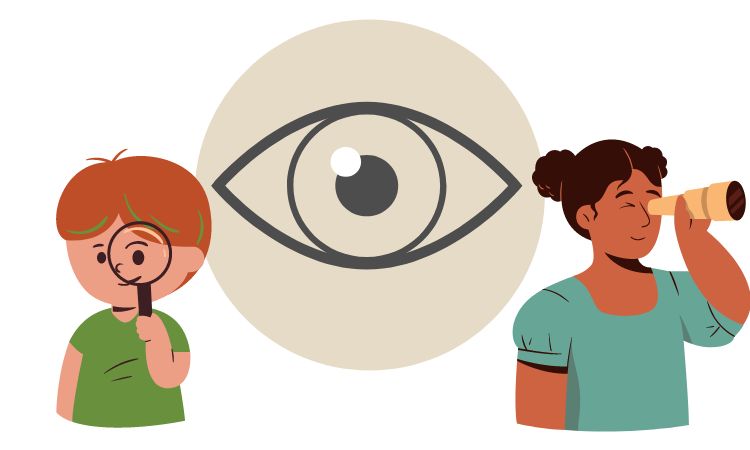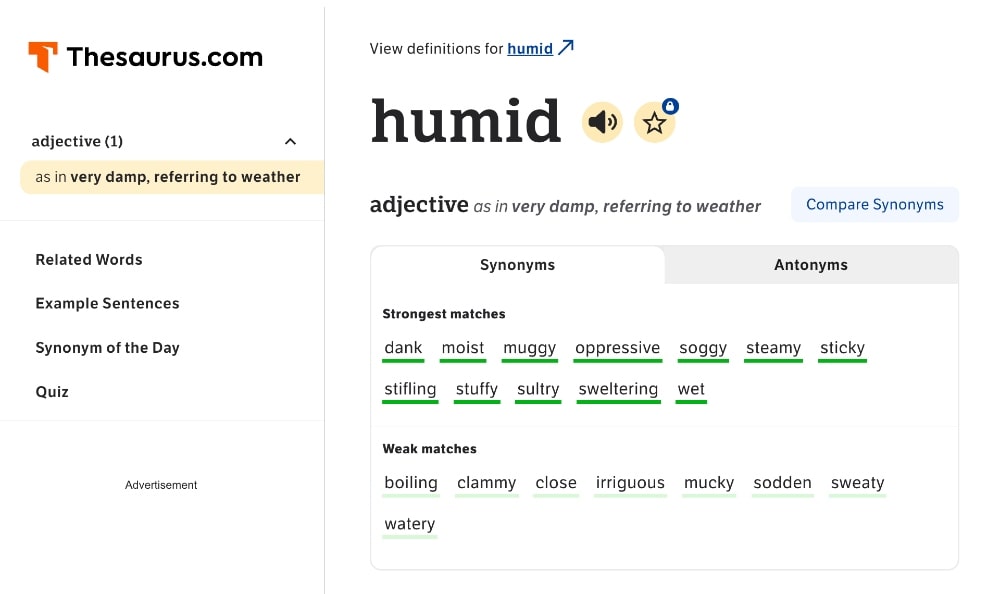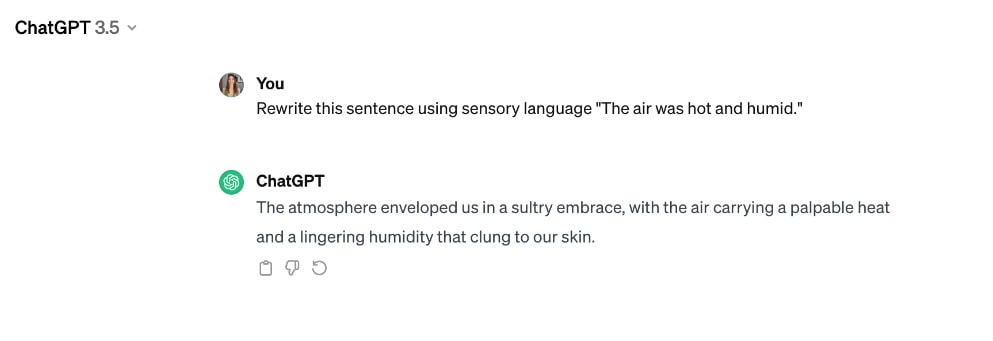Sensory language is a powerful tool in writing that taps into our five senses—sight, sound, taste, touch, and smell—to evoke emotions and create a vivid experience for the reader.
It’s not just about adjectives or adverbs; it’s about crafting sentences that conjure up imagery and sensations so real that readers feel immersed in the world you’re describing.
This technique is used across various genres, from poetry to marketing copy, to make the content come alive in the mind’s eye of the audience.
In this article, we delve into the 6 types of sensory language along with some examples and tips on how to incorporate the use of sensory language into your writing.
Whether you want to write better blog posts, tell better stories, make your ads more engaging, or something else entirely — this guide is going to be an important resource for you.
What is Sensory Language?
Sensory language, also known as imagery, brings writing to life through the use of vivid details that evoke the five senses:
- sight,
- sound,
- taste,
- touch,
- and smell.
This type of descriptive language allows writers to create a multisensory experience for their readers.
Instead of simply telling the reader what is happening, sensory language helps them visualize and feel the scene themselves, making it more memorable and engaging.
Incorporating sensory language into your writing can elevate it from ordinary to extraordinary, leaving a lasting impact on your audience.
Why is Sensory Language Important in Writing?
Sensory language is the key to creating emotional connections with readers.
By describing the world in a way that can be experienced with the senses, writers engage their audience on a deeper level.
This is crucial in character development, setting the scene, and guiding the emotional undertones of a narrative.
Moreover, sensory language heightens realism.
Think of a familiar smell or sound that instantly brings back a memory. In the same way, sensory language creates a world that the reader can recognize and relate to.
In conjunction with figurative language like metaphors and similes, it can also be one of the most effective tools for setting mood and tone.
Comparing Sensory Writing with Non-Sensory Writing
To better understand the impact of sensory language, let’s compare two pieces of writing that describe a forest:
Non-sensory Writing
- The trees were tall and lush.
- The air was hot and humid.
Sensory Writing
- The towering pine trees reached towards the sky, their branches rustling in the gentle breeze.
- The air was filled with the earthy scent of damp soil and the sound of birds chirping in the distance.
Can you see and feel the difference between these two descriptions? The sensory writing transports you into the scene, allowing you to experience it for yourself.
6 Types of Sensory Language
Each sense adds a unique layer to your prose. Let’s look at the different senses and how they can be employed to enrich your writing.
1. Visual Language

- Definition: Descriptions that conjure images in the reader’s mind.
- Example: “The sky was a brilliant sapphire as the sun dipped below the horizon.”
Visual sensory language refers to is perhaps the most common type of sensory language, but don’t let that detract from its power.
A vivid description that is also engaging visually can serve as the anchor point of your writing.
2. Auditory Language

- Definition: Words and phrases that describe sounds.
- Example: “The wail of a distant train whistle permeated the silence.”
Auditory language can establish both setting and mood.
Is the chirping of birds a sign of a tranquil morning, or is it a reminder of a character who can’t sleep because of a troubled mind?
3. Olfactory Language

- Definition: Depictions that describe smells.
- Example: “The sweet fragrance of jasmine wafted through the air.”
Scent can be the most evocative of the senses, often tied closely with memory.
Deploying olfactory sensory language examples that can be a powerful way to unlock visceral responses from your readers.
4. Gustatory Language

- Definition: Words that evoke taste.
- Example: “The soup was savory, a robust blend of herbs and seasonings.”
Though less commonly used, the sense of taste can provide an intimate touch to your writing, often able to convey sensations of comfort and nostalgia.
It can be especially effective in food writing, but don’t be afraid to experiment in other genres as well.
5. Tactile Language

- Definition: Text that conveys a sense of touch.
- Example: “The velvety petals of the rose felt cool against her skin.”
Incorporating tactile language allows your readers to feel the world you’ve created, touching and being touched by the story in a profound, almost intimate way.
It’s a way to make them experience the story rather than just reading it.
6. Kinesthetic Language

- Definition: Words that represent movement and physical sensations.
- Example: “His heart raced faster with each step he took.”
Kinesthetic language can add dynamism and movement to your writing, making it more immersive.
Through carefully chosen words, you can make your readers feel like they are part of the action, experiencing it alongside your characters.
Examples of Sensory Language in Writing
To truly grasp the impact and versatility of sensory language, let’s examine excerpts from literature that skillfully utilize these techniques.
A Tale of Two Cities by Charles Dickens
“Ding dong! The church bell had tolled thirty years, and still they tolled on. Ding Dong merrily, ding dong. The fluid toiled on; the silent river heaved; the dark, deep, gloomy night encompassed the city.”
This excerpt from the opening of A Tale of Two Cities not only creates auditory imagery with the sound of the church bell but also conjures up visual imagery with the description of the city at night.
Beloved by Toni Morrison
“120 is loud, but it’s that metasoft, like being in the sun, only better. Pickish, coming down, and quenching. Quenching. Then 124. Loud and long and such a haul on the last one you laugh, and then 125 means the white folks or the police are coming. The loudest stuff comes out the bell of 125. All of it.”
Here, auditory language is used to describe the sounds of numbers being shouted out. These descriptions are an integral part of the novel’s narrative structure.
6 Tips for Using Sensory Language Effectively
Now that we understand the various types of sensory language, how can we use them effectively in our writing?
1. Show, Don’t Tell
Instead of simply stating that a character is feeling sad, use sensory language to show the reader how they are experiencing sadness.
For example: “Tears streamed down her face as she hugged herself tightly, trying to hold in the sobs.”
This not only paints a more vivid picture but also allows the reader to feel the sadness alongside the character.
2. Use Specific, Evocative Words
Instead of using generic or overused words like “good” or “bad”, try to find specific and evocative words that convey a certain feeling or sensation.
For example: Instead of saying “The food was delicious,” you could say “The food was flavorful and satisfying, leaving a lingering warmth in my mouth.”
3. Don’t Overuse It
While sensory language is a powerful tool, it’s important not to overdo it.
Too much of anything can be overwhelming and lose its impact. Use sensory language sparingly and strategically, targeting moments that are crucial to the story or character development.
4. Be Consistent with Tone and Mood
Be mindful of the tone and mood you are trying to create when using sensory language.
For example, if you’re writing a horror story, the sounds and visuals should be dark, eerie, and unsettling rather than warm and inviting.
Consistency is key in creating a cohesive and immersive experience for the reader.
5. Use Sensory Language to Establish Setting
Sensory language can be a powerful tool for setting the scene and immersing your readers in the world you’ve created.
For example, instead of simply stating that it’s raining, describe how it feels and sounds: “The rain pelted against the window, creating a soothing symphony of pitter-patter.”
6. Practice and Experiment
As with any creative writing technique, the best way to improve is through practice and experimentation.
Try incorporating different types of sensory language in your writing and see what works best for you and your style.
Pay attention to how it affects the overall tone and mood of your writing, and don’t be afraid to revise and refine as needed.
Incorporating Sensory Language in Various Platforms
The platform you’re writing for will dictate the level of sensory language you use.
For example, if you’re writing a marketing email or business proposal, it’s important to use sensory language strategically and sparingly.
On the other hand, if you’re writing fiction or creative non-fiction, you have more freedom to experiment with sensory language and let your imagination run wild.
Sensory Language in Copywriting
Incorporating sensory language in copywriting can be a powerful tool to engage and persuade customers.
By appealing to their senses, you can create a more emotional connection with your audience and make your product or service stand out amongst competitors.
In a long-form blog post, feel free to expand on sensory details to build the world of your topic.
On social media, where space is limited, focus on a couple of strong sensory moments to pique interest.
In a podcast script, balance out auditory descriptions with engaging verbal storytelling and possibly enhance it with some sound design to give your listeners a multi-sensory experience.
Sensory Language in Email Marketing
In email marketing, sensory language can be used to create a sense of urgency or exclusivity.
For example: “Don’t miss out on our limited edition holiday flavor! The warm aroma and rich taste of cinnamon will transport you back to cozy memories with loved ones.”
Sensory Language in Social Media
On social media platforms where visual content is king, sensory language can be used to enhance the visuals and create a more immersive experience for the audience.
For example: “Take a bite into our new triple chocolate cake and let the creamy, decadent layers melt in your mouth.”
Sensory language can also be used in captions to create a more emotive and engaging message, rather than simply stating facts or information.
Practice Sensory Language With These Writing Prompts
Feeling inspired to practice more sensory language now? Here are some prompts to get you started:
- Choose a setting. It could be the beach, a bustling city square, or your childhood home. Write a paragraph about it, using sensory language to immerse the reader.
- Work on character development. Describe one of your characters entering a room without saying who they are. Use sensory details to convey their personality or current emotional state.
- Think of a memory. It could be either happy or sad. Use sensory language to describe it as if the reader is experiencing it alongside you.
- Describe an everyday object. It could be an apple or a table or a pen. Write a paragraph about its texture, smell, and sound when touched or used in various ways.
- Imagine a place you’ve never been. Use mental images to write what you think this place might look, feel, and sound like.
This mental practice will help you start to dive into the sensory details that you need to create vivid imagery in your writing.
Tools to Enhance Sensory Language in Writing
Use a thesaurus to find descriptive words that go beyond the simple, obvious choices to find the word that best captures the sense you want to convey.
For example, when you type “humid” into thesaurus.com, you’ll find these suggested words:
- dank
- moist
- muggy
- oppressive
- soggy
- steamy

And so on. This is a great way to replace normal, overused words with better, sensory words.
As you become more comfortable with sensory language, give AI writing tools like GPT-3 a whirl to beef up your writing.
ChatGPT can turn this:
- The air was hot and humid.
Into this:
- The atmosphere enveloped us in a sultry embrace, with the air carrying a palpable heat and a lingering humidity that clung to our skin.

FAQs About Sensory Language
Conclusion
Utilizing sensory language is a powerful tool for writers to engage their readers and bring stories or descriptions to life. It allows the audience to fully immerse themselves in the narrative, creating a more memorable and impactful experience.
The next time you read anything – whether that’s a book or a piece of marketing copy – take a look at how the author employs sensory language.
Notice how it adds depth, emotion, and imagery to the writing. Then, try your hand at incorporating sensory details into your own writing and see how it transforms your work.
Start with AI tools for writing to help you get the hang of it and use a thesaurus when you need swap out specific words for sensory words.
So go forth and add some spice, tangibility, and depth to your writing with sensory language!
Check out our article on writing a personal narrative to learn more about how you can write better stories for your audience!